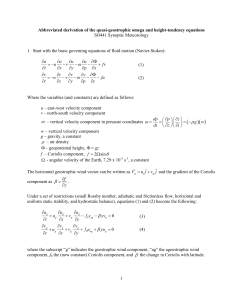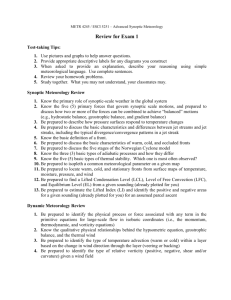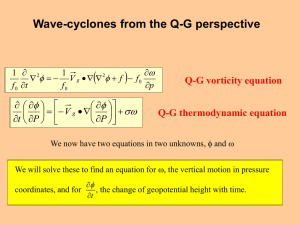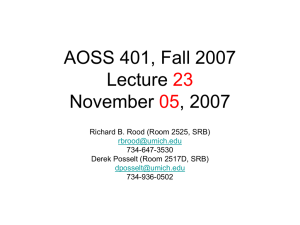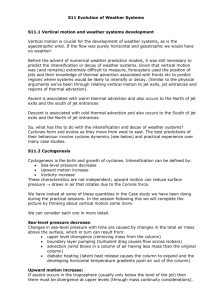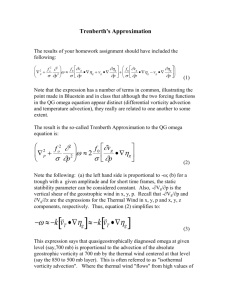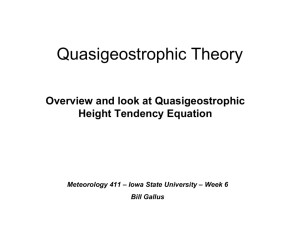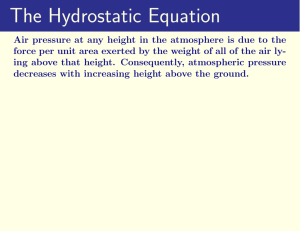Geopotential tendency and vertical motion
advertisement
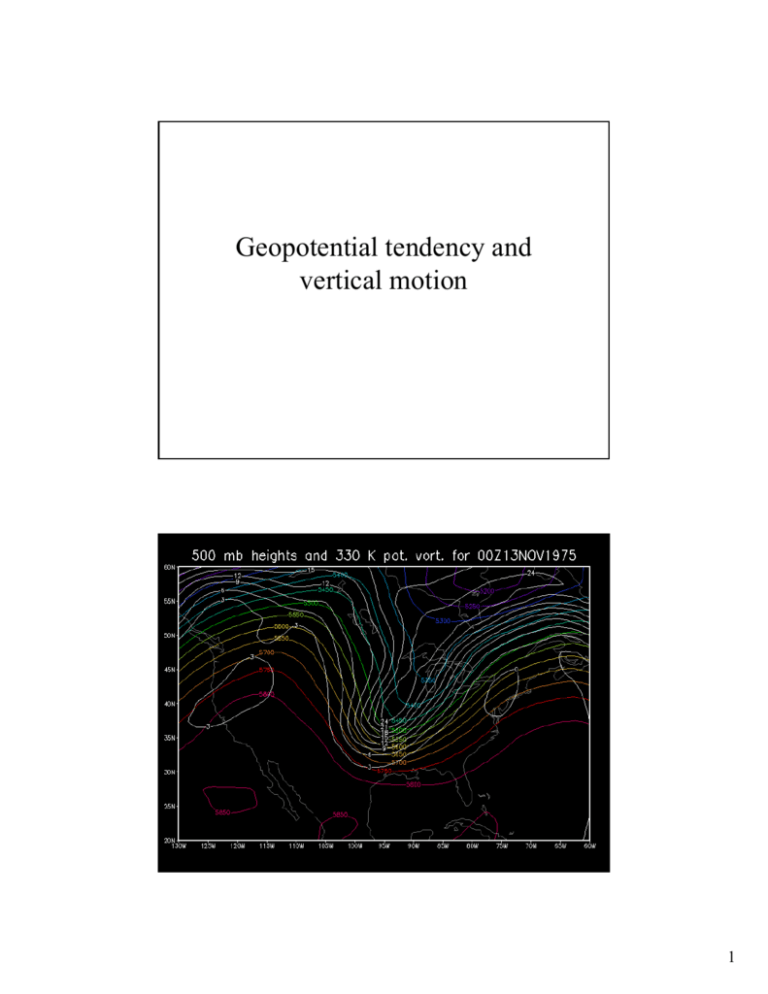
Geopotential tendency and vertical motion 1 Recall PV inversion… • Knowing the PV, we can estimate everything else! (Temperature, wind, geopotential …) • In QG, since the flow is geostrophic, we can obtain the wind field exactly. Then with thermal wind balance, obtain the temperature exactly. • More generally (i.e., not QG), need to assume a number of “balance” conditions to do the PV inversion. Example: PV inversion with ozone •Ozone concentrated in stratosphere •PV concentrated in stratosphere (stronger stability) •PV conservation means PV behaves like a passive tracer (much like ozone) So, could use measurements of ozone to guess PV field then invert this derived PV to obtain wind field Then use thermal wind equation to deduce temperature field Would be useful near tropopause and lower stratosphere where wind measurements are difficult Would this work? 2 Ozone measured from TOMS PV calculated from weather observations Davis et al. (1999), QJRMS, 125, 3375-3391 200hPa wind from PVozone Davis et al. (1999), QJRMS, 125, 3375-3391 3 Example: more PV anomalies PV near tropopause PV near surface + P’>0 + L - P’<0 P’>0- L + - H P’<0 H + PV anomaly shaded Potential temperature, and wind anomalies contoured Hoskins et al. (1985), QJRMS, 111, 877-946 Example: Vertical coupling forced at 250 hPa Amount of vertical inversely proportional to length scale (as Laplacian “selects” for smaller scale). Consider scale (via m-1): ψ = sin mz ∂ψ = m cos mz ∂z ∂ 2ψ = − m 2 sin mz ∂z 2 = − m 2ψ large m small m Again, an artifact of the “smoothing” associated with the eleptic 4 Example: Impact of aspect ratio Recall vertical and horizontal scales are related to f and σ. Specifically, k/m ~ f2/σ Consider scale (via k-1): ψ = sin mz ~ sin kx ∂ψ ~ k cos kx ∂z ∂ 2ψ ~ −k 2 sin kx ∂z 2 ~ −k 2ψ So more vertical propagation for longer waves (k small, k-1 large) large k small k In future we will see that this means, for long waves, upper troposphere flow, can mess with lower troposphere flow. 5 Geopotential tendency (a synoptic meteorology view of QG) i.e., “PV is nice and all, but geopotential makes more sense to me!” Prognostic geopotential equation QG vorticity equation: QG thermodynamic equation: ∂ζ g ∂t = −Vg ⋅ ∇(ζ g + f ) + f 0 ∂ω ∂p R J ∂ ∂Φ − σω = + Vg ⋅ ∇ − cp p ∂t ∂p • As a consequence of conservation of QG PV 2 ∂ f 02 ∂ ∂Φ 1 = − f 0 Vg ⋅ ∇ ∇ 2 Φ + ∇ + ∂ p ∂ p t ∂ σ f0 ∂ f2 ∂Φ f − 0 Vg ⋅ ∇ p ∂ ∂p σ Notice left hand side is an elliptic operator for the tendency (which can be solved given boundary conditions) Terms on the right are all in terms of geopotential 6 Geopotential tendency equation 2 ∂ f 02 ∂ ∂Φ 1 = − f 0 Vg ⋅ ∇ ∇ 2 Φ + ∇ + ∂p σ ∂p ∂t f0 ∂ f2 ∂Φ f − 0 Vg ⋅ ∇ ∂p ∂p σ temperature advection vorticity advection • Thermal advection dominates development. (stronger in lower troposphere) • Through thermal wind balance, ensures that low level development is associated with upper level change (surface cyclogenesis causes upper level trough, etc) • Notice this suggests a transfer of energy from potential energy (related to thickness/goepotential height) to kinetic energy (more vorticity, and stronger wind speeds) • This conversion is fundamental to the general circulation QG prediction QG vorticity ζg = 1 2 ∇Φ f0 ∂ζ g ∂t = − Vg ⋅ ∇(ζ g + f ) + f 0 ∂w ∂p vorticity stretching vorticity advection (ageostrophic) Given Φ, can compute ug and vg. What about vertical velocity? Eliminate it! (Use thermodynamic equation.) 2 ∂ f 02 ∂ ∂Φ 1 = − f 0 Vg ⋅ ∇ ∇ 2 Φ + ∇ + ∂p σ ∂p ∂t f0 ∂ f2 ∂Φ f − 0 Vg ⋅ ∇ ∂p ∂p σ vorticity advection Recall Laplacian gives dΦ < 0 when dζ > 0, etc Vertical difference in temperature advection Inverting Laplacian tends to smooth. (And give a minus sign) Also, elliptic equations have solutions! 7 Geopotential tendency 2 ∂ f 02 ∂ ∂Φ 1 = − f 0 Vg ⋅ ∇ ∇ 2 Φ + ∇ + ∂ p ∂ p t ∂ σ f0 ∂ f2 ∂Φ f − 0 Vg ⋅ ∇ p σ ∂ ∂p • Φ falls with (positive) vorticity advection (cyclonic) • Φ falls with when warm air advection increases with height (or when cold air advection decreases with height) Example: • Warm air advection at the surface causes increased thickness • Increased thickness causes high pressure at layer top • High pressure creates ageostrophic horizontal motion • Unbalanced ageostrophic drives divergence (mass lost from layer) • Divergence lowers heights, and creates low pressure at surface (still high pressure at layer top ) • Surface low causes convergent ageostrophic motion for balance • So knowing geopotential can estimate "omega" with QG! 8 QG vertical motion • ω was eliminated in prediction equation, but is important for, for instance, stretching. • Specifically, if we want the ageostrophic divergence, need to be able to extract it from horizontal geostrophic flow • Different estimates of ω are subject to different errors in equations (this is a practical issue) • Consider momentum equation? Continuity? Thermodynamic? Each ω as a residual from a difference in large quantities. ∂ua ∂va ∂ω + + =0 ∂x ∂y ∂p • R J ∂ ∂Φ − σω = + Vg ⋅ ∇ − cp p ∂t ∂p Expect most accurate method to be based on state of geopotential rather than change in geopotential (as, e.g., in vorticity equation) 9

